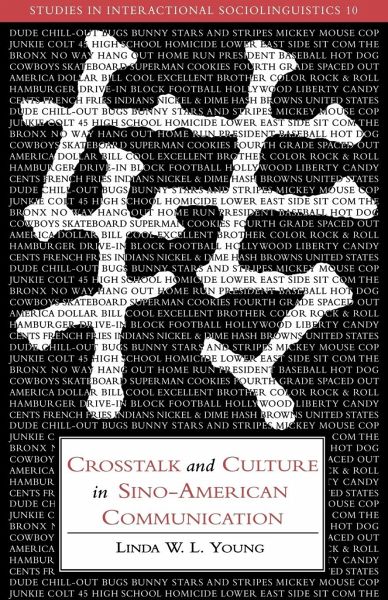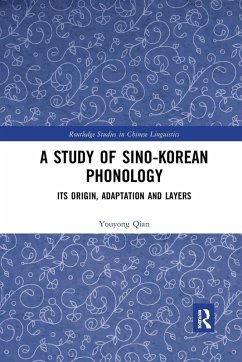
CrossTalk and Culture in Sino-American Communication
Versandkostenfrei!
Versandfertig in 1-2 Wochen
50,99 €
inkl. MwSt.

PAYBACK Punkte
25 °P sammeln!
Linguistic examination of the cultural trappings of talk to explain Sino-American miscommunication.Chinese and Americans often unwittingly communicate at cross purposes because they are misled by the cultural trappings of talk. This book aims to clarify their misunderstandings by examining their different ideals and strategies of talk. It draws on cultural, philosophical, and linguistic insights and traces the development of Chinese communicative strategies from Confucius through the 'eight-legged essay' to the boardrooms and streets of Hong Kong. Its formal analysis of taped interchanges and ...
Linguistic examination of the cultural trappings of talk to explain Sino-American miscommunication.
Chinese and Americans often unwittingly communicate at cross purposes because they are misled by the cultural trappings of talk. This book aims to clarify their misunderstandings by examining their different ideals and strategies of talk. It draws on cultural, philosophical, and linguistic insights and traces the development of Chinese communicative strategies from Confucius through the 'eight-legged essay' to the boardrooms and streets of Hong Kong. Its formal analysis of taped interchanges and in-depth interviews reveals Chinese speakers' distinctive ways of communicating and relating. Crosstalk and Culture in Sino-American Communication will alert people to the pitfalls of cultural misunderstandings and the hidden assumptions and expectations underlying talk.
Review quote:
"...[the book] has much to offer our understanding of intercultural communication....Young speaks eloquently on the cultural trappings of talk. Her work is an insightful reference for those interested in cross-cultural East-West communication
Quarterly Journal of Speech
"This admirable book illuminates many of the details of Chinese and American conversational styles and exposes them for what they are, distinct linguistic and cultural features to be recognized and respected . . ." -Language
"...a useful tool for anyone who is involved in relations with China and Chinese societies....Young brings to this study her linguistic expertise and uniqueness as an Asian-American and bridge person in Sino-American communication....With clarity and succinctness the author gives excellent indepth descriptions of Confucianism and Chinese preoccupation with ritualistic actions and behavior....I highly recommend Crosstalk and Culture."
Franklin J. Woo, China News Update
"Young calls our attention to the importance of understanding the perspective of our interlocutors in cross-cultural settings. Her work has certainly contributed a great deal to our appreciation of how and why our Chinese interlocutors speak the way they do." --China Review International
"Throughout her well-written book, Young does an admirable job of summarizing and bringing to bear a wide variety of sociolinguistic, anthropological, philological and philosophical analyses of both Chinese and American linguistic behavior, while at the same time realistically limiting and qualifying her claims....significant parts of this book can profitably inform cross-cultural understanding in a wide variety of situations..."
The Journal of Asian Studies
"In seven interesting and often enlightening chapters Young makes a very well documented case for understanding the "crosstalk" phenomenon through Lin Yutang's metaphor of "English meat with Chinese bones," meaning that the words may be English, but the understanding and intention they carry remain Chinese (p.181)....the book should be seen as a major contribution to our understanding of cross-linguistic and cross-cultural influences on miscommunication."
Jan W. Walls, Pacific Affairs
Table of contents:
Foreword by John J. Gumperz; Preface; Acknowledgments; 1. The Ps and cues of Chinese inscrutability; 2. Deceptive cause; 3. Missing links; 4. Backforwardly speaking; 5. Effacing talk; 6. Mistaking turns; 7. Parting words; References; Indexes.
Chinese and Americans often unwittingly communicate at cross purposes because they are misled by the cultural trappings of talk. This book aims to clarify their misunderstandings by examining their different ideals and strategies of talk. It draws on cultural, philosophical, and linguistic insights and traces the development of Chinese communicative strategies from Confucius through the 'eight-legged essay' to the boardrooms and streets of Hong Kong. Its formal analysis of taped interchanges and in-depth interviews reveals Chinese speakers' distinctive ways of communicating and relating. Crosstalk and Culture in Sino-American Communication will alert people to the pitfalls of cultural misunderstandings and the hidden assumptions and expectations underlying talk.
Review quote:
"...[the book] has much to offer our understanding of intercultural communication....Young speaks eloquently on the cultural trappings of talk. Her work is an insightful reference for those interested in cross-cultural East-West communication
Quarterly Journal of Speech
"This admirable book illuminates many of the details of Chinese and American conversational styles and exposes them for what they are, distinct linguistic and cultural features to be recognized and respected . . ." -Language
"...a useful tool for anyone who is involved in relations with China and Chinese societies....Young brings to this study her linguistic expertise and uniqueness as an Asian-American and bridge person in Sino-American communication....With clarity and succinctness the author gives excellent indepth descriptions of Confucianism and Chinese preoccupation with ritualistic actions and behavior....I highly recommend Crosstalk and Culture."
Franklin J. Woo, China News Update
"Young calls our attention to the importance of understanding the perspective of our interlocutors in cross-cultural settings. Her work has certainly contributed a great deal to our appreciation of how and why our Chinese interlocutors speak the way they do." --China Review International
"Throughout her well-written book, Young does an admirable job of summarizing and bringing to bear a wide variety of sociolinguistic, anthropological, philological and philosophical analyses of both Chinese and American linguistic behavior, while at the same time realistically limiting and qualifying her claims....significant parts of this book can profitably inform cross-cultural understanding in a wide variety of situations..."
The Journal of Asian Studies
"In seven interesting and often enlightening chapters Young makes a very well documented case for understanding the "crosstalk" phenomenon through Lin Yutang's metaphor of "English meat with Chinese bones," meaning that the words may be English, but the understanding and intention they carry remain Chinese (p.181)....the book should be seen as a major contribution to our understanding of cross-linguistic and cross-cultural influences on miscommunication."
Jan W. Walls, Pacific Affairs
Table of contents:
Foreword by John J. Gumperz; Preface; Acknowledgments; 1. The Ps and cues of Chinese inscrutability; 2. Deceptive cause; 3. Missing links; 4. Backforwardly speaking; 5. Effacing talk; 6. Mistaking turns; 7. Parting words; References; Indexes.














